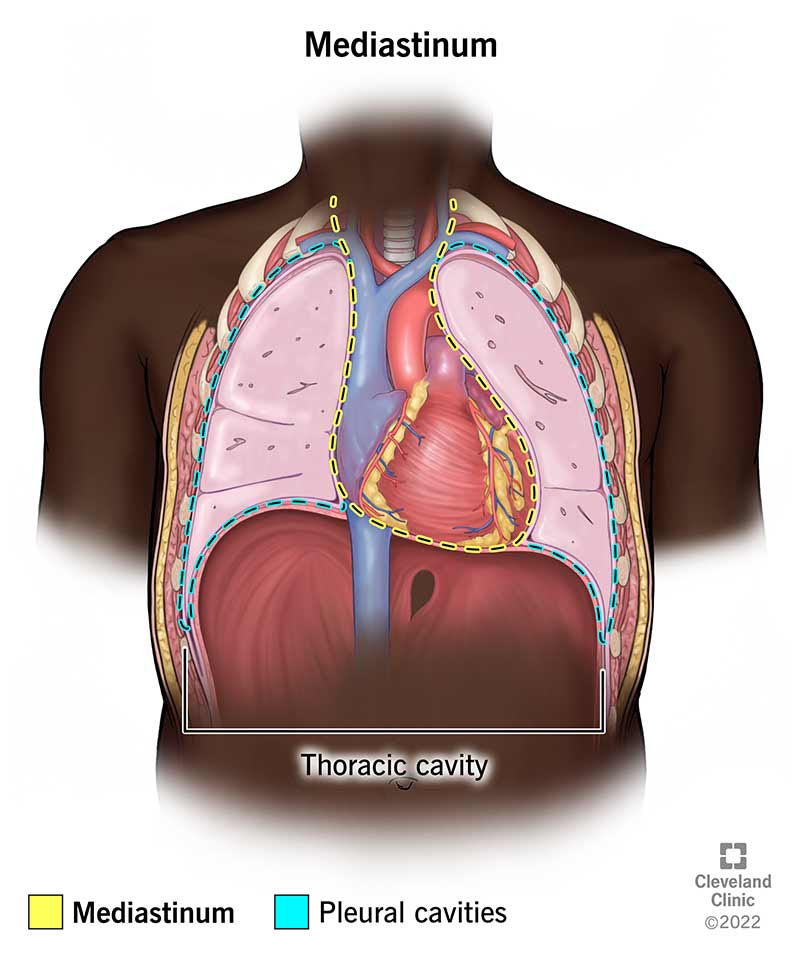Your mediastinum is a space in your chest that holds your heart and other important structures. It’s the middle section of your thoracic cavity, between your left and right pleural cavities (which hold your lungs). Many conditions can affect the organs and tissues in your mediastinum, including tumors and infections.
Your mediastinum is a space within your chest that contains your heart and other structures.
Your mediastinum is one of the three main compartments that make up your thoracic cavity. The other two compartments are your left pleural cavity (holds your left lung) and your right pleural cavity (holds your right lung). Your mediastinum is the space between these two pleural cavities.

Your mediastinum is the middle section of your thoracic cavity. It's located between your two pleural cavities (left and right).
Your mediastinum contains many different structures, including organs and blood vessels.
Organs in your mediastinum include your:
Blood vessels in your mediastinum include your:
Other structures in your mediastinum include:
Advertisement
Cleveland Clinic is a non-profit academic medical center. Advertising on our site helps support our mission. We do not endorse non-Cleveland Clinic products or services. Policy
Your mediastinum has several important functions, including:
Your mediastinum is located in the middle of your chest between your lungs. Mediastinum means “midway” in Latin. Its boundaries are as follows:
Advertisement
Your mediastinum is divided into several parts, which researchers call compartments. There are different classification systems for organizing these compartments. The main idea to know is that your mediastinum can be divided into either three or four parts. And their names refer to their position in your chest.
The traditional or classical model divides your mediastinum into four parts:
This model is based on X-ray images of your heart. So, it takes a two-dimensional view of your heart.
The International Thymic Malignancy Interest Group (ITMIG) developed the more recent three-compartment model. It’s based on cross-sectional imaging (CT scans) and takes a three-dimensional view of your heart. This model divides your mediastinum into three parts:
Prevascular compartment
The prevascular compartment is in front of your heart, between your heart and your breastbone. Structures inside this compartment include:
Visceral compartment
The visceral compartment is the middle part, which contains your heart. Structures inside this compartment include:
Paravertebral compartment
The paravertebral compartment is the part behind your heart, between your heart and your spine. Structures in this compartment include:
It’s also helpful to remember that your mediastinum is a three-dimensional (not flat) space. It’s a bit like a diorama that you build inside a small box. The structures inside are arranged in a particular way to help your body function. But certain conditions can affect the organs and tissues in your mediastinum and disrupt its careful balance.
Many different conditions can affect the organs and tissues in your mediastinum. Some conditions begin in the mediastinum, such as primary tumors or cysts. Other times, a disease (like cancer) spreads to your mediastinum from somewhere else in your body. Infections that affect your whole body (systemic) can also impact your mediastinum.
Some conditions that may affect your mediastinum include:
These conditions have a wide range of symptoms and treatments. Talk with your provider about your condition to learn more about what you can expect.
A widened mediastinum means that your mediastinum is at least 8 centimeters wide. This is a clinical sign your healthcare provider sees when viewing your mediastinum from back to front on an X-ray.
A widened mediastinum could indicate a wide range of conditions, including:
Advertisement
Tests your provider may use to check your mediastinum include:
Your provider may order testing to find the cause of symptoms you’re having. Or, you may need testing on a regular basis to monitor an issue. Talk with your provider about the testing you need, why you need it and how to prepare.
A healthy lifestyle can help lower your risk of many conditions that affect your mediastinum. Some tips include:
A note from Cleveland Clinic
Your mediastinum is a space in your chest that holds your heart and other important structures. It’s the middle compartment within your thoracic cavity, nestled between your lungs.
It can be easy to forget that your mediastinum is there. That’s because most people focus on what’s inside it (like your heart). But it’s helpful to learn mediastinum anatomy and the terms scientists use, especially if you or a loved one are diagnosed with a related condition. Talk with your provider if you have questions about your mediastinum or its role in your health.
Last reviewed on 08/29/2022.
Learn more about the Health Library and our editorial process.
Advertisement
Cleveland Clinic is a non-profit academic medical center. Advertising on our site helps support our mission. We do not endorse non-Cleveland Clinic products or services. Policy